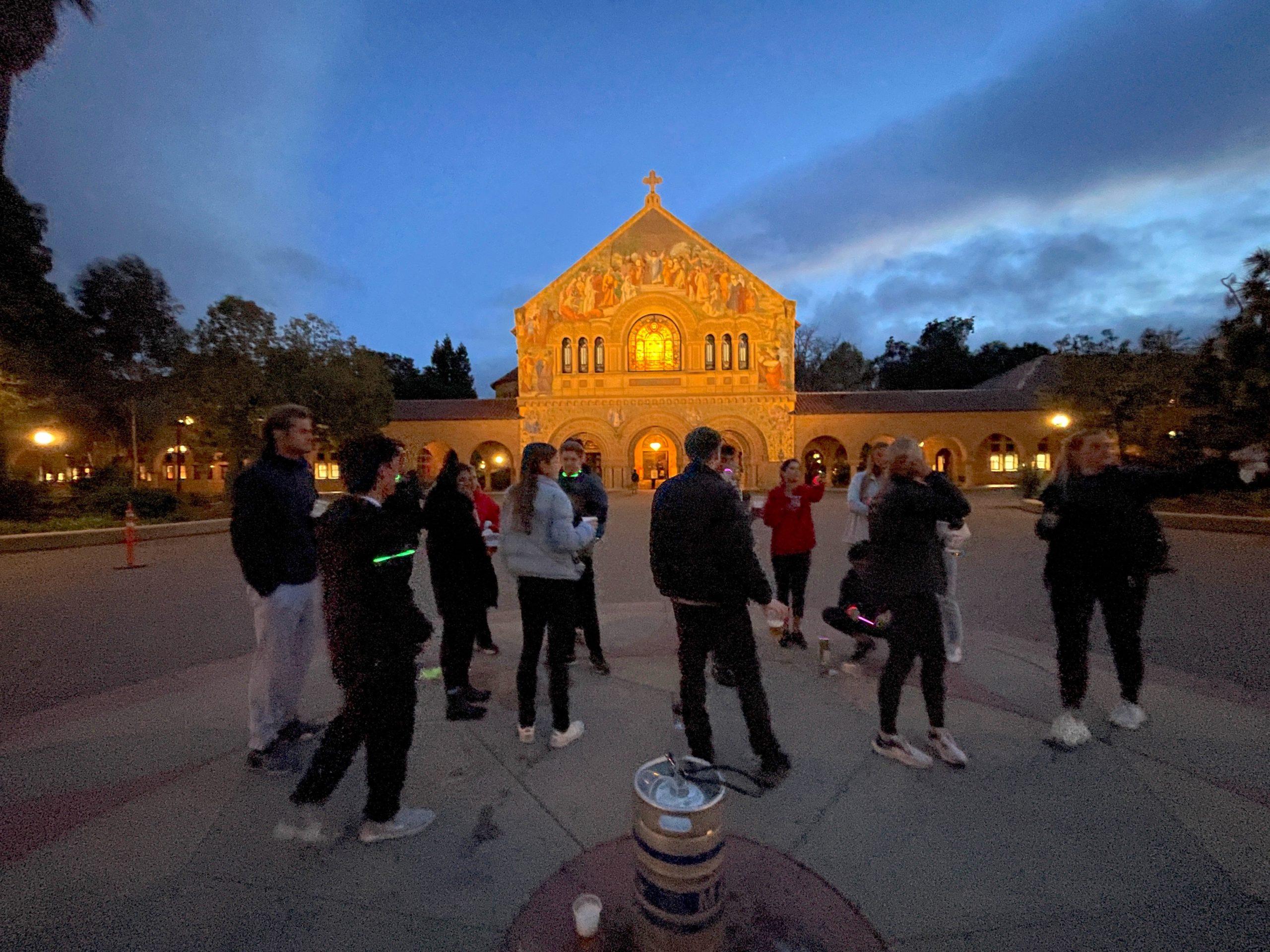Project 1: Social / Party Game
Campus Capture the Flag

Creators: Allie Littleton, Blake Sharp, Alex Tsai
Artist’s statement
We set out to create a game that would both encourage students aged 21+ to explore and engage with their college campus while providing a fun activity to socialize with friends.
Some of our best childhood memories involve running around friends’ backyards, summer camps, or even P.E. class, playing outdoor games like capture the flag. These games let us bond with friends, engage our minds through strategy sessions, and enjoy the outdoors and friendly competition. As we have gotten older, we have noticed that this type of game is less common among our peers. Instead, people our age tend to gravitate toward activities more traditionally conducive to partying, such as drinking games that take place in crowded dorm rooms or dingy basements.
We set out to create a game that would combine the youthful joy of outdoor, active games and the desire of students aged 21+ to socialize with their friends in a party-like setting. We also wanted to use this opportunity to encourage students — wide-eyed freshmen and nostalgic seniors alike — to explore and engage with their college campus. After many rounds of brainstorming and iterating, we came up with Campus Capture the Flag — we hope you enjoy!
Concept map (pdf)
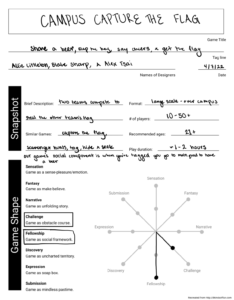
Initial decisions about formal elements and values
As we developed and iterated on our game, we thought deeply about the formal elements and values that would affect play. The primary values of our game are exercise, fellowship, and competition. There are two opposing teams, each with their own territory tasked with the goal of capturing the other team’s flag. To capture the flag, players must cross into enemy territory to find the opposing team’s flag without getting tagged — if they get tagged, they are sent to “jail” and must walk to the neutral zone to drink a beer before returning to the game. The mechanics of Campus Capture the Flag gives rise to a game of athleticism, social collaboration, and teamwork. As an aside, while our game prototype involved drinking alcohol, we included modifications for non-drinking in our rules.
One crucial component of the game not included in our formal elements is the flag. Each team’s flag is a bottle of wine, and to successfully capture the flag, each team must not only find the flag and bring it back to their team’s territory, they must also finish the entire bottle of wine (requiring teamwork to ensure everyone is drinking a reasonable amount)!
Below are the formal elements of Campus Capture the flag:
Players: Our game can be played with at least 4 and up to 50 players. Each player belongs to one of two teams, and while there are no formally defined roles, each player usually chooses to focus on either the offensive (running into enemy territory to capture the flag) or defensive (defending the flag by tagging opposing players) aspect of the game. We created a compelling invitation to play by creating a Facebook event and inviting several of our close friends, encouraging them to join in on a night of camaraderie, fun, and connection with campus. The player interaction pattern is a team competition putting two teams in competition against each other.
Objectives: The primary objective of our game is capture — in this case, each team must capture the other team’s flag.
Procedures: The procedures of the game are as follows:
1. Before the game begins, players split into two teams. Each team hides their flag within their team territory. The predetermined campus-related task is also made known to each team.
2. The game begins, and the two teams must compete to capture the other team’s flag without getting tagged and complete the one predetermined, campus-related task.
3. The game ends when one team has successfully completed the campus-related task and captured the other team’s flag.
Resources: The primary resource in Campus Capture the Flag is the number of players active (if you are tagged, you are rendered inactive during the time it takes for you to drink a beer at the neutral zone.)
Conflict: Conflict in our game arises between player opponents, as the game involves tagging opposing players. The obstacles in our game — the requirement of completing a task — also contributes to conflict.
Boundaries: Physical boundaries are a crucial element in our game, as it determines the size of the playing field on which players can tag each other and hide the flag. As elaborated on below in our iteration history, we made several revisions to our game boundaries.
Outcome: The outcome of the game is zero sum — there can only be one team winner.
As a result of its formal elements, the primary aesthetic of Campus Capture the Flag is fellowship. First, teamwork is critical to winning the game, as each team must successfully play offense to capture the flag and defense to tag opposing players. The mechanics of capturing the flag requires a shared effort to finish the alcohol in the wine bottle (the flag), which demands teamwork and cooperation.
Testing and iteration history
We had three main iterations. The first iteration was when we decided to shift the game a little further away from traditional capture the flag. Since the game revolved around being on Stanford’s campus, we decided to add a rule to allow the players to engage with their surroundings. Now in order to win, the players would have to steal the other teams flag, finish the alcohol in the flag (wine bottle), and complete a campus related task. For Stanford’s campus, we added the task should be a photo of 60% of your team at a fountain in your boundaries.
The second was around our boundaries. We originally drafted the boundaries for the game depicted below. We then asked three friends to walk the boundaries with us to see how they felt about the size of the playing field. After the walkthrough, we decided we had outlined an area of campus that was too big. So we shifted to a more contained field. Then on the night we had organized our large playtest, we decided to shrink the boundaries even further. We assessed the number of people who had showed up to play and the area of the Main Quad and realized that just Main Quad would be big enough. So we shifted the boundaries to encompass the area in the arcades and inner part of Main Quad to play in. This would also shift the task we could give the players. So we shifted the task from a photo in the fountain to a photo of team members with their feet off the ground (whatever that means) in one of the large planters on their side.
We had brought together about twenty five of our friends last Thursday night to playtest our game. We ran three rounds of our game to get a feel for how people interacted with it. After the teams had hid their flags and the first game commenced, the green team went on the offensive and had the other team’s flag back to their side within two minutes. They finished their wine bottle and completed their task within the next minute. So we realized we needed to change a few rules to make the game last longer. For the next iteration, we decided to allow the teams to hide their flags. The next two play tests lasted at least twenty minutes and left both sides feeling like there was more of a competition. These second two playtests were much more successful than the first. We witnessed many smiles, laughs, taunts, and shrieks of delight. We overall found our final playtest to be highly successful.
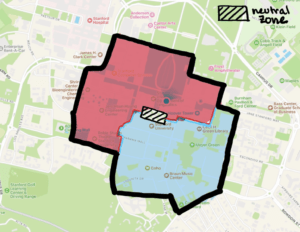 Original boundaries
Original boundaries
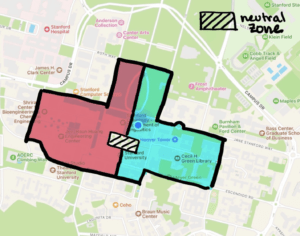 Revised boundaries
Revised boundaries
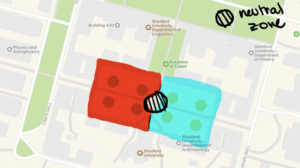 Final boundaries
Final boundaries
Final prototype
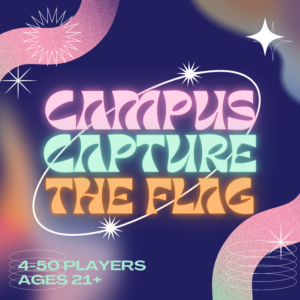 Box design
Box design
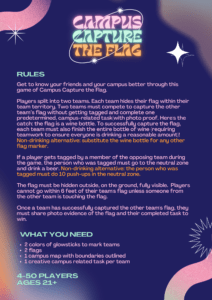 Rules
Rules
Video of the final playtest
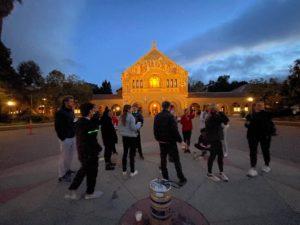 Our participants in front of Memorial Church
Our participants in front of Memorial Church
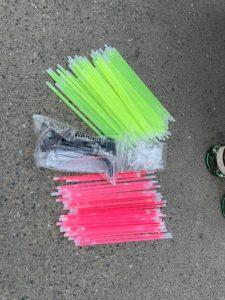 Game setup: glowstick distribution
Game setup: glowstick distribution
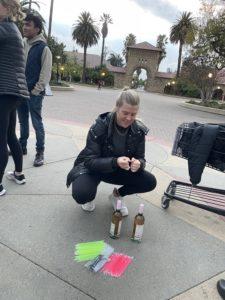 Game setup: attaching glowsticks to flags
Game setup: attaching glowsticks to flags


